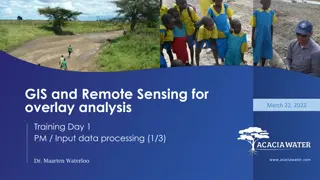Understanding Senior and Persons with Disabilities Awareness and Sensitivity Training
This training focuses on defining disabilities, highlighting health care access issues, understanding the ADA and Section 504, and emphasizing the importance of providing inclusive and accessible health care services for seniors and persons with disabilities to ensure their well-being and quality of life.
Download Presentation

Please find below an Image/Link to download the presentation.
The content on the website is provided AS IS for your information and personal use only. It may not be sold, licensed, or shared on other websites without obtaining consent from the author. Download presentation by click this link. If you encounter any issues during the download, it is possible that the publisher has removed the file from their server.
E N D
Presentation Transcript
Senior and Persons with Disabilities (SPD) Awareness and Sensitivity Training Cultural & Linguistics
Our Objectives for today are: 2) Definition of disability as defined by Americans with Disability Act (ADA) 3) Health Care Access issues for people with disabilities 4) Types of disabilities and what do SPDs need? 5) Best practices 1) Who are Seniors and Persons with Disabilities (SPDs)? a) ADA Law
Who are Seniors and Persons with Disabilities? Seniors are adults 65 years and older. Seniors are aging population that are impacted with conditions that affects the health and behaviors which influence the quality of health. Persons with disabilities include children ad adults with disability that meet the social security Administration (SSA) disability standards.
What is disability? Disability as defined by the Americans with Disabilities Act (ADA) is either; Physical or mental impairment that substantially limits one or more major life activities; or Record of physical or mental impairment that substantially limits a major life activity; or Being regarded as having such an impairment.
ADA and Section 504 of the Rehabilitation Act This law stipulates that health care providers must ensure full and equal access to their health care services and facilities. The Federal Civil Rights Law was passed to: Protects person with disabilities, similar to the protection on the basis of race, color, sex, national origin, age and religion Ensure access to health care programs and services with reasonable accommodation and providing effective communication. Health care facilities must ensure that their facilities are accessible to people with disabilities. When possible medical equipment should be accessible. Examples: accessible examination tables, accessible imaging machines, accessible scales, and patient lifts. Health care providers must have an accessible facility that meets the 2010 ADA Standards for Accessible Design and have accessible exam/ treatment/procedure rooms available.
Disability and Health Care Access Did you know? About 1 in 4 people in the United States have a disability. Studies have shown that people with disabilities are less likely to get preventive health care services they need to stay healthy. The lack of physical accessibility adversely affects quality of care, leading to delayed and incomplete care, missed diagnoses, exacerbation of the development of secondary conditions. Studies have shown that adults with a disability are obese, smoke, have a heart disease and diabetes: 38.2 percent of adults with disability are obese as compared to 26.2 precent adults without disability are obese. 28.2 percent of adults with disability smoke while 13.4 percent of adults without a disability smoke. 11.5 percent of adults with disability have heart disease while 3.8 percent of adults without disability have heart disease. 16.3 percent of adults with a disability have diabetes while 7.2 percent of adults with a disability have diabetes. Disability is part of human experience, but sometimes people use words or phrases that are insensitive and do not promote understanding, dignity, and respect for people with disabilities.
SPDs what do they need? Access to, inside and within the building Height adjustable exam tables Wheelchair accessible weight scales Interpreter Services and Assistive Listening Devices
Tips on how to interact with our SPD populations First of all, relax If you are not sure on what to do, just ask Do not be embarrassed if you use common terms like See you later or Did you hear that? Focus on the person, not the disability Disabilities do not define a person Assume that a person CAN do something, rather than assuming they CAN T. they will let you know if that are able or not. Always ask before helping Offer your arm for balance, if needed Do not grab the person s arm (or other body parts).
The dos and Donts! Acceptable-Neutral Unacceptable-Offensive She has a disability; she is a person with a disability She is disabled; handicapped; crippled He has cerebral palsy He is afflicted with; stricken with, suffers from; a victim of cerebral palsy She has a congenital disability She has a birth defect He uses a wheelchair; has a wheelchair He is confined to a wheelchair; wheelchair bound She has a developmental disability; intellectual disability She is retarded; slow She is an older person with disability She is frail He doesn t have a disability He is normal; whole; healthy; abled-bodied
Quiz Time Which of the following is the definition of Disability as defined by the ADA? a. Physical or mental impairment that substantially limits one or more major life activities b. Record of physical or mental impairment that substantially limits a major life activity c. Being regarded as having such an impairment d. All of the above
Quiz Time Seniors are adults 65 years and older. a. True b. False
Quiz Time Which of the following do SPDs need? a. Access to, inside and within the building b. Height adjustable exam tables c. Wheelchair accessible weight scales d. Interpreter services and assistive listening devices e. All of the above
Quiz Time Which of the following is acceptable when referring to SPD populations? a. He has cerebral palsy b. She is retarded; slow c. She has a developmental disability; intellectual disability d. Both a and c
Quiz Time Due to barriers, individuals with disabilities are less likely to get routine preventative medical care than people without disabilities. a. True b. False
Conclusion People with disability often have more compromised health, accessibility to doctors' offices, clinics, and other health care providers is essential in providing medical care to senior and persons with disabilities. Due to barriers, individuals with disabilities are less likely to get routine preventative medical care than people without disabilities. Accessibility is not only legally required, but also important medically so that minor problems can be detected and treated before turning into major and possibly life-threatening problems.
Thank You DUALSPDSENSTRNG07242024























